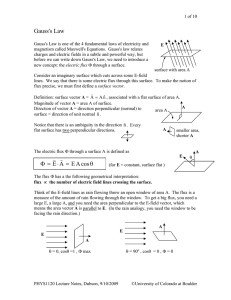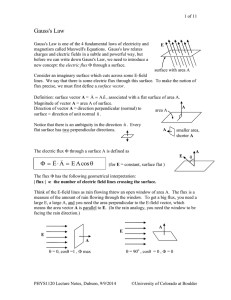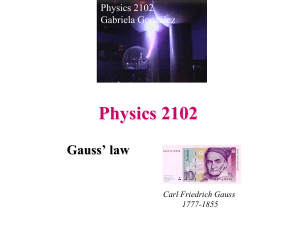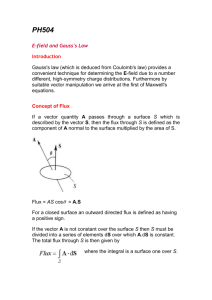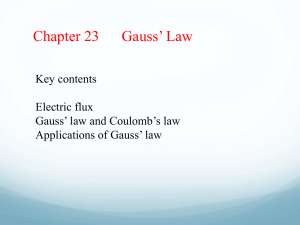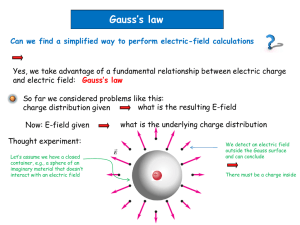Gauss - University of Colorado Boulder
advertisement
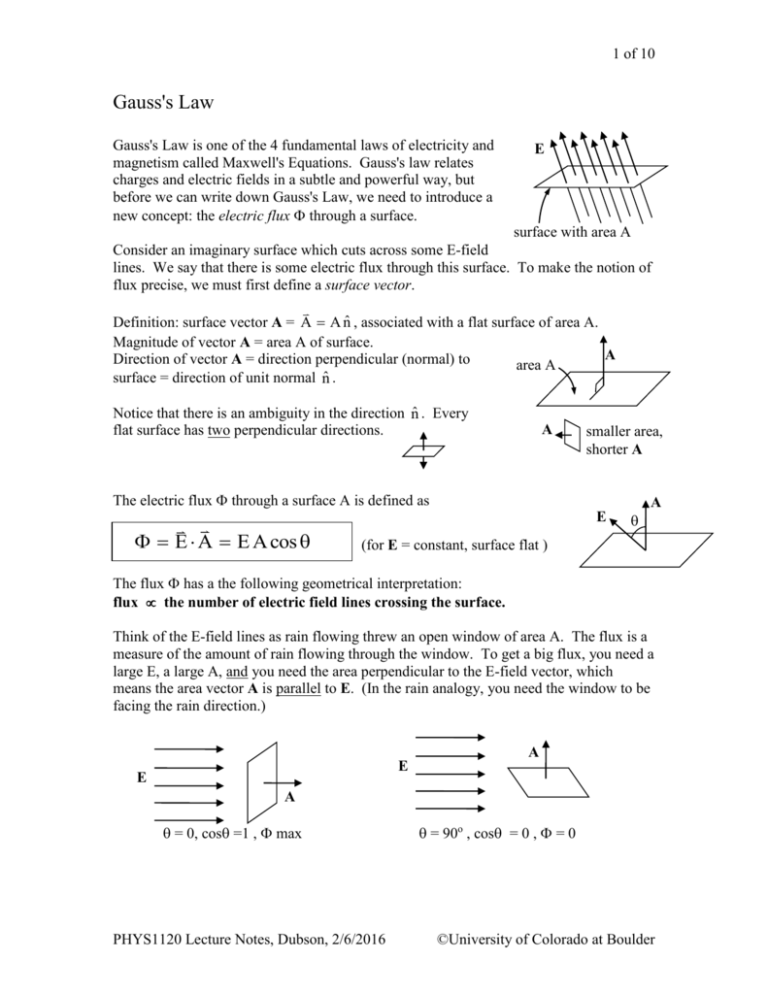
1 of 10 Gauss's Law Gauss's Law is one of the 4 fundamental laws of electricity and magnetism called Maxwell's Equations. Gauss's law relates charges and electric fields in a subtle and powerful way, but before we can write down Gauss's Law, we need to introduce a new concept: the electric flux through a surface. E surface with area A Consider an imaginary surface which cuts across some E-field lines. We say that there is some electric flux through this surface. To make the notion of flux precise, we must first define a surface vector. Definition: surface vector A = A A nˆ , associated with a flat surface of area A. Magnitude of vector A = area A of surface. A Direction of vector A = direction perpendicular (normal) to area A surface = direction of unit normal n̂ . Notice that there is an ambiguity in the direction n̂ . Every flat surface has two perpendicular directions. A smaller area, shorter A The electric flux through a surface A is defined as A E E A E A cos (for E = constant, surface flat ) The flux has a the following geometrical interpretation: flux the number of electric field lines crossing the surface. Think of the E-field lines as rain flowing threw an open window of area A. The flux is a measure of the amount of rain flowing through the window. To get a big flux, you need a large E, a large A, and you need the area perpendicular to the E-field vector, which means the area vector A is parallel to E. (In the rain analogy, you need the window to be facing the rain direction.) A E E A = 0, cos =1 , max PHYS1120 Lecture Notes, Dubson, 2/6/2016 = 90o , cos = 0 , = 0 ©University of Colorado at Boulder 2 of 10 (A cos is the projection of the area A onto the plane perpendicular to E. It is the area which "faces the rain". Only the area facing the rain gives flux. E A E area = A cos The formula E A is a special case formula: it only works if the surface is flat and the E-field is constant. If the E-field varies with position and/or the surface is not flat, we need a more general definition of flux: E da "surface integral of E" E E da To understand a surface integral, do this: in your imagination, break the total surface up into many little segments, labeled with an index i. The surface vector of segment i is da i . If the segment is very, very tiny, it is effectively flat and the E-field is constant over that tiny surface, so we can use our special case formula E A . The flux through segment i is therefore i E i da i . (Ei is the field at the segment i) The total flux is the sum: E da i i i E da (In the limit that the segments become infinitesimal, there are an infinite number of segments and the sum becomes an integral.) In general, computing surface integral E da can be extremely messy. So why do we care about this thing called the electric flux? The electric flux is related to charge by Gauss's Law. PHYS1120 Lecture Notes, Dubson, 2/6/2016 ©University of Colorado at Boulder 3 of 10 Gauss's Law E da (the 1st of 4 Maxwell's Equations) q enclosed 0 In words, the electric flux through any closed surface S is a constant (1/0) times the total charge inside S. E da closed surface integral "closed" da A surface is closed if it has no edges, like a sphere. For a closed surface, the direction of da is always the outward normal. 1 . 4 0 The constant 0 is related to k by k Fcoul k q1 q 2 r2 da 1 q1 q 2 4 0 r 2 0 8.85 1012 (SI units) Gauss' Law can be derived from Coulomb's Law if the charges are stationary, but Gauss's Law is more general than Coulomb's Law. Coulomb's Law is only true if the charges are stationary. Gauss's Law is always true, whether or not the charges are moving. It is easy to show that Gauss's Law is consistent with Coulomb's Law. From Coulomb's kQ 1 Q Law, the E-field of a point charge is E 2 . We get the same result by r 4 0 r 2 applying Gauss's Law: r E da + S E da E da (since E is parallel to da on S) (since E is constant on S) EA imaginary spherical surface S, radius r Solving for E, we have E E 4 r2 Q 0 (says Mr. Gauss) 1 Q . Done. 4 0 r 2 PHYS1120 Lecture Notes, Dubson, 2/6/2016 ©University of Colorado at Boulder 4 of 10 When viewed in terms of field lines, Gauss's Law is almost obvious (after a while). Recall that flux is proportional to the number of field lines passing through the surface. Notice also that flux can be positive or negative depending on the angle between the Efield vector and the area vector. Where the field lines exit a closed surface, the flux there is positive; where the field lines enter a closed surface, the flux there is negative. So the total flux through a closed surface is proportional to [(# field lines exiting) – (# field lines entering)] da da E (exiting S) E (entering S) If a closed surface S encloses no charges, then the number of lines entering must equal the number of lines exiting, since there are no charges inside for the field lines to stop or start on. imaginary surface S E E da 0 S S So only charges inside the surface can contribute to the flux through the surface. Positive charges inside produce positive flux; negative charges produce negative flux. – + The net flux is due only to the net charge inside: E da q enclosed . 0 Using Gauss's Law to solve for the E-field Gauss's Law is always true (it's a LAW). But it is not always useful. Only in situations with very high symmetry is it easy to compute the flux integral E da . In these few cases of high symmetry, we can use Gauss's Law to compute the E-field. PHYS1120 Lecture Notes, Dubson, 2/6/2016 ©University of Colorado at Boulder 5 of 10 Example of Spherical Symmetry: Compute E-field everywhere inside a uniformly-charged spherical shell. + + + By symmetry, E must be radial (along a radius), so E = E(r). We choose an imaginary surface S concentric with and inside the charged sphere. + + + + + S Q + + + Since the E-field is radial and the surface vector da on S is also radial, we have E da E da . (The dot product of the parallel vectors is just the product of the magnitudes.) So we have E da S E da E da EA , where A is the area of surface S. We are able to take E outside the integral only because E = E(r) and so E = constant on the surface S. q Gauss's Law says E da enc 0 , so we have E A = 0 , E = 0. 0 S Conclusion: E = 0 everywhere inside a hollow uniform sphere of charge. If you draw the spherical gaussian surface S outside the charged shell, you can quickly 1 Q rˆ everywhere outside the shell. The E-field outside a uniform show that E 4 0 r 2 shell of charge, or outside any spherically symmetric charge distribution, is exactly the same as if all the charge was concentrated at the center. Example of Cylindrical Symmetry: Compute E-field around an infinite line of charge with charge per length = . gaussian surface S, radius r, length L r +++++++++++++++++++++++++++ +++++ L By symmetry, E is in the cylindrically radial direction and E = E(r). E in plane to line area of curved side = A = 2 r L r L PHYS1120 Lecture Notes, Dubson, 2/6/2016 ©University of Colorado at Boulder 6 of 10 E da S E da ends E da E da EA side side side 0 E (2 r L) The charge inside the gaussian surface is (charge/length)length = L, so Gauss gives gives E da E (2 r L ) S q enc L 0 0 E 2 0 r Example of Planar Symmetry: Compute the E-field near an infinite plane of charge with Q charge per area . A By symmetry, the E-field must be perpendicular to the plane (either away or towards). end cap area A E + + + + + + + gaussian surface charge encosed da da da On end caps, E da E da On curved side, E da 0 q A E da enc0 2EA 0 E = constant, regardless of position ! 2 0 PHYS1120 Lecture Notes, Dubson, 2/6/2016 ©University of Colorado at Boulder 7 of 10 E = constant E = constant uniform plane of charge (seen edge-on) Conductors in Electrostatic Equilibrium "Electrostatic equilibrium" means that all charges are stationary; so the net force on every charge must be zero (otherwise the charge would be accelerating). Useful facts about metals (conductors) in electrostatic equilibrium: The electric field in the interior of a metal must be zero. The E-field must be zero in the interior, otherwise the conduction electrons in the metal would feel a force F = q E = –e E and would move in response. Electrons in motion would mean we are not in electrostatic equilibrium. In a conductor, the charges arrange themselves so the E = 0 everywhere in the interior (otherwise, the charges are not yet in equilibrium and continue to move). The interior of a conductor in equilibrium can have no net charge (electrons and protons must have equal density). Proof from Gauss's Law: consider any closed surface within the conductor, E da 0 (since E = 0) S q enclosed 0 S conductor Any net charge on the conductor resides only on the surface of the conductor. PHYS1120 Lecture Notes, Dubson, 2/6/2016 ©University of Colorado at Boulder 8 of 10 We just showed that no net charge can exist in the interior, so it must be on the surface. The electric field must be perpendicular to the surface of the conductor. The E-field must be perpendicular to the surface (in electrostatic equilibrium), otherwise the component of the E-field along the surface would push electrons along the surface causing movement of charges (and we would not be in equilibrium). On the surface of metal, if Ex was not zero, there would be a force Fx = q Ex = –e Ex on electrons in the metal pushing them along the surface. E Ex metal net charge on surface only E-field surface E = 0 inside A metal in electrostatic equilibrium . 0 [Note: this is similar, but different than the formula for the field near a plane of charge: E .] 2 0 The E-field near the charged surface of the conductor has magnitude E Proof by Gauss's Law: air gaussian "pillbox" S, A = area of one cap = charge per area ++++++++++++++++++ metal E da qenc 0 EA A 0 PHYS1120 Lecture Notes, Dubson, 2/6/2016 E 0 ©University of Colorado at Boulder 9 of 10 Why not E da 2EA ? Because E = 0 inside metal E air metal E = 0 inside metal But now, a very puzzling situation has arisen ! We proved before that an infinite plane of charge creates a uniform field E . But now we have also proved that a plane of 2 0 charge on the surface of a metal makes a field E . 0 + E + + 0 + E + 2 0 + + + + + + + + + + + + + + + + + How can both be correct? The E-field near the surface of a metal is not only due to the charges on that nearby surface. The E-field is always due to all charges, including charges on far-away surfaces! PHYS1120 Lecture Notes, Dubson, 2/6/2016 ©University of Colorado at Boulder 10 of 10 Metal slab with net positive + charge. + + + + + + + + + + + surface 1 + + (Assume that the surfaces on the top and bottom are small + and far away so that Etot is due to surfaces 1 and 2 only.) + + + + E tot E1 E 2 + 2 0 2 0 0 + + + + + + + surface 2 + The charges all arrange themselves so that E = 0 inside the metal E just outside metal 0 PHYS1120 Lecture Notes, Dubson, 2/6/2016 ©University of Colorado at Boulder
